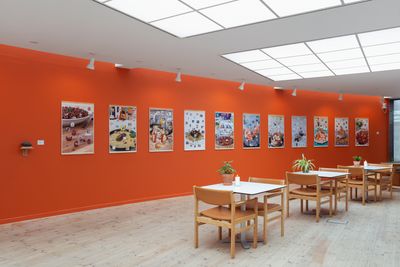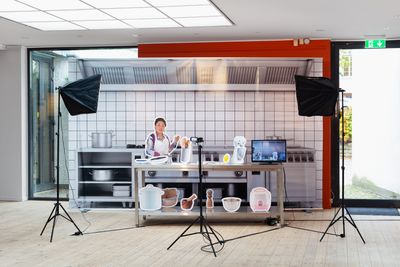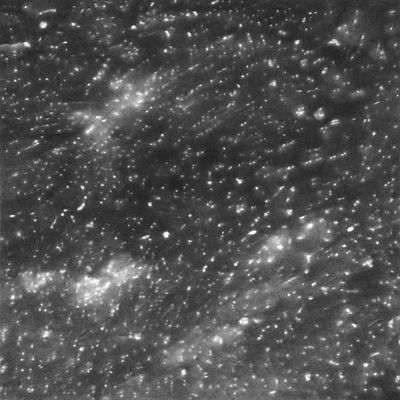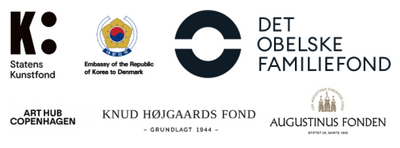Minimalism-𝗠𝗮𝘅𝗶𝗺𝗮𝗹𝗶𝘀𝗺-𝕄𝕖𝕔𝕙𝕒𝕟𝕚𝕤𝕤𝕞𝕞𝕞
–
–
Participating Artists:
Act 1: Kang Dongju (KR), Asger Dybvad Larsen (DK), Silas Inoue (DK), Pernille Kapper Williams (DK), Oso Parado (MX)
Act 2: Chanmi Heo (KR), Kent Iwemyr (SE), Trevor Shimizu (US), Nho Wonhee (KR)
Act 3: Kasper Hesselbjerg (DK), The Dumpling Club (NL)
Act 4: Lola Daels (BE), Ali Kazim (PK), Seulgi Lee (KR/FR), Elsa Salonen (FI), Tove Storch (DK), Studio ThinkingHand (DK)
Guest Curators:
Acts 1–3: Jacob Fabricius; Act 4: Mikkel Hammer Elming
Collaborating Partner:
Art Sonje Center, Seoul
Kunsthal Aarhus is proud to present Minimalism-Maximalism-Mechanissmmm, a group exhibition in four acts realised in collaboration with Art Sonje Center, Seoul. Staging artistic formats which examine how artists select, use and process materials to tell stories about their surroundings and daily life, the project focuses on how a contemporary art institution presents itself to its artists and audiences, getting visitors to experience and learn how abstract and meaningful connections can be created in space.
About the Exhibition
The exhibition enables audiences to encounter multiple ways of viewing and questioning curatorial and institutional approaches to exhibition making. The title has several connotations. ‘Minimalism’ refers to an art movement which began after World War II in the Western art world.
One movement is often a reaction to others and thus the term ‘maximalism’, which hints at an aesthetic of excess, is a reaction to the principles of the Minimalist movement. A ‘mechanism’ is part of a larger process, as we observe in abstract and physical systems, and a set of multiple mechanisms is typically called a machine.
The arts, which are composed of a myriad of systems and workings, might therefore be called an art machine. Lastly, ‘ssmmm’ is a purposeful misspelling. It is intended to be read as a stutter, as if a machine was getting stuck and making repeated, mechanical noises. When visiting an arts institution frequently, audiences might have an experience that seems to stutter, that repeats itself and seems stuck.
Act 1 and Act 2 are intended to generate a contemplative relationship between the artwork, its making, and the observer. Act 1 presents a grouping of minimalistic art consisting of tactile and sensual works on canvas and on paper, as well as mixed media sculptures. Embedded in these works are the material traces left behind by their own making, which reveal how the artistic process is a fundamental element of each work. Their materiality is mainly influenced by the ways they were touched by nature and/or an urban setting. For instance, Kang Dongju’s drawings are propelled by night walks, during which she traced patterns on pavements to mimic starry night skies. Act 2 presents paintings where the artists have created narrative stories from urban and rural areas. Whilst the storytelling is generated through the artists’ memory, their materiality is experienced through the canvas, or the real and fictional characters they depict. Kent Iwemyr’s paintings, for example, tell stories about people and odd events that he has experienced in or around the small community in Sweden where he lives.
Act 3 invites audiences to interact with the works and actively participate with their hands, minds and bodies. For instance, the artist collective The Dumpling Club wants people to participate, share and co-produce recipes that establish relations. Stories unfold while making and eating dumplings, transforming a banal cooking session into a community-based experience focused on stories which centre around immigration, the entanglement between food and identity, and a longing for different futures.
Titled Archive of Aesthetic Exploration, Act 4 is an accessible cabinet of curiosities. It consists of an archive where audiences are invited to explore hundreds of small artworks stored in boxes, and a laboratory where visitors can set up and juxtapose artworks taken from the archive. In this way, they get to experience how the practice of curating can influence the relationship between artwork and viewer. As an example, Tove Storch’s series of untitled, glazed ceramic plates gives visitors a rare opportunity to get close to her seductive world by touching their delicate surfaces.
In the first iteration of the show at Art Sonje Center (20.01.2022 – 06.03.2022; 17.03.2022 – 24.4.2022), the exhibition was divided into four acts. At Kunsthal Aarhus, the first three are unified, edited, and condensed in such a way that the previously distinct lines between the acts blur. All acts shift away from a traditional format which uses a physical and static display, and move towards a participatory, relational and activating exhibition.
Events in Conjunction with the Exhibition
On the 14th of October 2022, 4 – 6 PM: event by artist Kasper Hesselbjerg. As a part of the exhibition’s Act 3 you can experience work by Danish artist Kasper Hesselbjerg (b. 1985). Among other pieces, Hesselbjerg will be presenting at this exhibition, he will be displaying 'Chocolate Chip Sea Cucumber Soft Ice on Ice', 2022. As a part of the opening it will be possible for visitors to not only experience - but also taste Hesselbjerg’s 'Chocolate Chip Sea Cucumber Soft Ice on Ice' in unique stoneware glazed bowls.
On the 07th of January 2023, 3 – 9 PM: workshop by artist collective The Dumpling Club.
About the Curators
Jacob Fabricius (b. 1970, DK) has been Director of Art Hub Copenhagen since 2021. Previous positions include: Artistic Director of Kunsthal Aarhus (2016–2021), Director of Kunsthal Charlottenborg (2013–2014), and Director of Malmö Konsthall (2008–2012). He has curated several exhibitions internationally including, most recently, the 2020 Busan Biennale, South Korea. In addition to these roles, he is the founder and managing editor of Pork Salad Press.
Mikkel Hammer Elming (b. 1990, DK) is Director of Glasmuseet Ebeltoft. He has a master’s degree in art history from Aarhus University, with a specialisation in curating contemporary art. He is the co-founder and former director of the Association for Contemporary Art, Aarhus, and of the contemporary art center Regelbau 411, Thyholm. In recent years he has worked as curator at Kunsthal Aarhus.
Special Thanks
Shin Dokho, Cho Eunchae, Galleri Magnus Karlsson (Stockholm), Kim Haeju, Cho Heehyun, Kim Jang Un, Kim Sunjung, Moon Jeongyeon, Kvadrat A/S, Lee Seolhui, V1 Gallery (Copenhagen)
‘Minimalism-Maximalism-Mechanissmmm’, Kunsthal Aarhus, 2022-2023. Courtesy of Kunsthal Aarhus.





